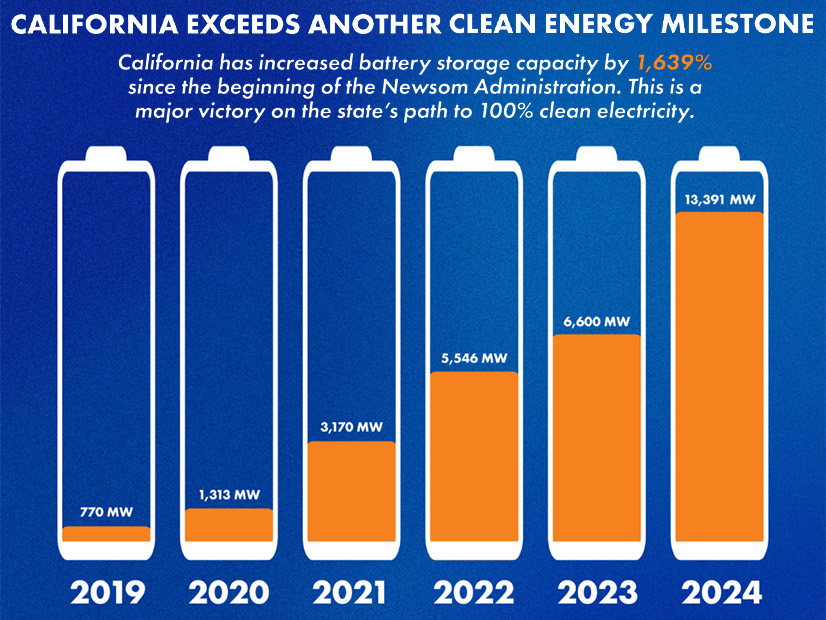
As the growth in battery capacity is accelerating, the new milestone is one-quarter of the way to the state’s projected need of 52 GW of battery storage capacity by 2045.
California’s battery energy storage capacity has hit 13,391 MW, an increase of 3,012 MW in just six months and a milestone that Gov. Gavin Newsom’s office called “a major victory on the state’s path to 100% clean energy.”
As the growth in battery capacity is accelerating, the new milestone is one-quarter of the way to the state’s projected need of 52 GW of battery storage capacity by 2045.
Industry experts cited the growth of battery storage as a key factor in the Western grid having an “uneventful” summer — despite enduring the hottest weather on record. (See Batteries, Energy Transfers Support ‘Uneventful’ Summer in West.)
Batteries are also key to capturing solar energy that’s produced during the day so it can be used when the sun isn’t shining, Newsom’s office said. Battery discharge to the grid increased from 6,000 MW this spring to more than 8,000 MW over the summer.
“These are the essential resources that we’ll continue needing more of as the climate crisis makes heat waves hotter and longer,” Newsom said in a statement.
According to a CAISO special report on battery storage, battery charging accounted for about 8.3% of load in the CAISO balancing area during peak solar hours in 2023.
“During these hours, batteries help reduce the need to curtail or export surplus solar energy at very low prices,” the report said.
Most of the state’s current battery storage capacity comes from 187 utility scale installations totaling 11,462 MW.
Residential battery storage adds 1,354 MW of capacity in 193,070 installations across the state, according to a California Energy Commission (CEC) dashboard. The remaining 576 MW of capacity is from 3,211 commercial installations.
Broken down by region, the 93501 and 92225 ZIP codes have the most battery storage capacity: 1,450 MW and 1,051 MW, respectively. Both areas are in the Southern California desert.
Grid Support Program
California’s battery storage milestone comes as the state is seeing growth in a program aimed at maintaining grid reliability during extreme weather events.
The CEC’s Demand Side Grid Support (DSGS) program pays participants to reduce electricity use or send energy to the grid to reduce the risk of rolling blackouts. The program runs from May through October.
Since its launch in August 2022, the DSGS program has grown to 265,000 participants and 515 MW of capacity, the CEC announced Oct. 15.
The program includes what the CEC describes as one of the largest storage virtual power plants in the world, with a capacity of more than 200 MW. The VPPs are a network of customer-owned battery storage systems — usually paired with solar — that send power to the grid.
In addition to storage VPPs, the program has two other ways to participate. Participants may provide non-combustion resources, such as traditional demand response. It’s also open to demand response aggregators participating in the CAISO market.
So far in 2024, the virtual power plant has been activated 16 times and demand response was activated once, “helping to avoid a grid crisis during four separate heat waves from July through the beginning of October,” the CEC said.
The DSGS program also played a role in the September 2022 heat wave, when it reduced electricity demand by 3,000 MWh during the 10-day event.
DSGS is part of the state’s Strategic Reliability Reserve, created in 2022 through Assembly Bill 205. The reserve is intended to expand the resources available to manage or reduce net-peak demand during extreme events.


